
Wheat disease models
Wheat blast
Pathogen
Pyricularia grisea, also known as Magnaporthe oryzae, is a fungal pathogen responsible for wheat blast, a significant disease affecting wheat crops. The pathogen primarily reproduces asexually through conidia (asexual spores), which serve as the primary inoculum for initiating infections. These conidia are produced on conidiophores and are dispersed by wind, rain, and mechanical means, such as agricultural equipment. Upon landing on a susceptible wheat host, the conidia germinate and form appressoria—specialized structures that facilitate penetration into the plant tissue. Once inside, the fungus colonizes the host cells, leading to disease development. Environmental conditions play a crucial role in the infection process of P. grisea. The fungus thrives in warm, humid climates, with temperatures ranging from 15°C to 30°C and extended periods of leaf wetness or high relative humidity. Continuous leaf wetness for at least 14 hours is necessary to initiate infection, making excessive cloud cover, high humidity, over-irrigation, and mistimed irrigation conducive to disease development. Additionally, stress factors such as drought, soil compaction, low mowing heights, and excessive nitrogen fertilization can exacerbate the severity of the disease.
Symptoms
The initial symptoms of wheat blast manifest as water-soaked, diamond-shaped lesions on the leaves, which later turn gray as the disease progresses. These lesions can expand and coalesce, leading to extensive leaf blight and necrosis. Infected spikes exhibit partial or complete bleaching, often starting from a blackish-gray infection point at the rachis or the base of the spikes. Under high inoculum pressure, multiple infection points can occur on a single rachis, resulting in significant yield losses. In addition to foliar symptoms, P. grisea can infect other above-ground parts of the wheat plant, including the nodes and necks, leading to rotten neck or node blast. This can cause the affected parts to break, resulting in lodging and further yield reduction. The pathogen’s ability to infect various parts of the plant throughout the growing season makes it particularly destructive, especially under favorable environmental conditions.
FieldClimate model
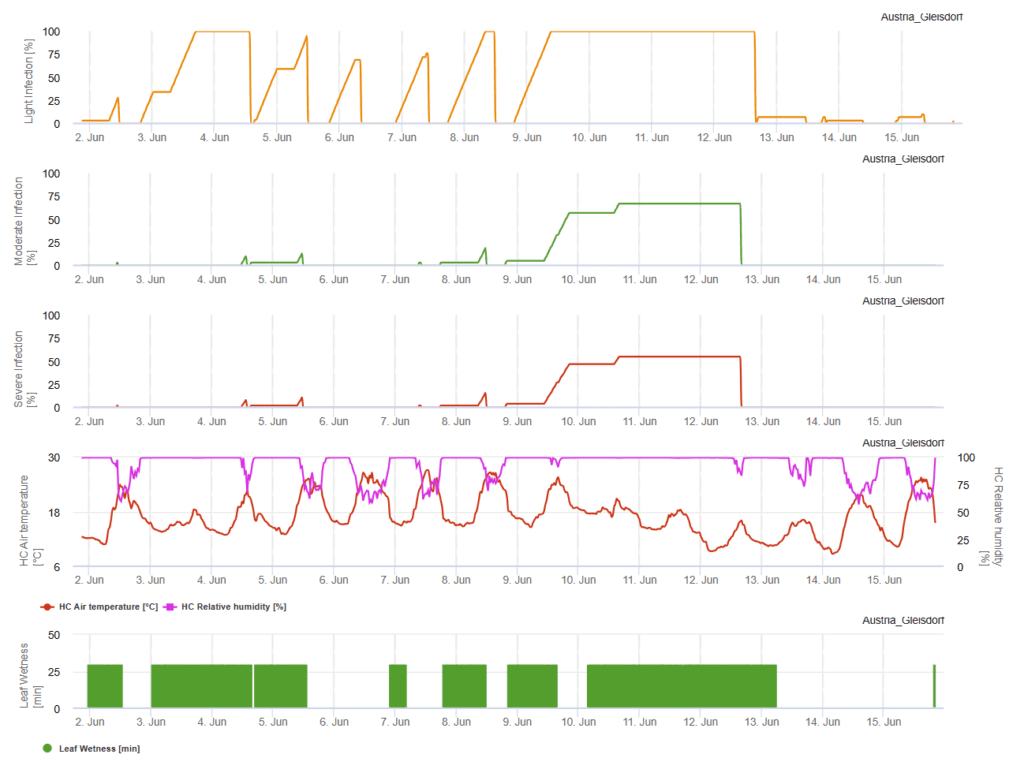
Sensors needed:
- Air Temperature
- Relative Humidity
- Leaf Wetness
Cloudy skies, humid conditions and drizzles favor the development and severity of the disease. In FieldClimate we calculate three severity classes and when 100% of infection are reached optimal conditions for the fungal pathogen have been given in the field. In dependence of the variety, field history curative plant protection measurements have to be taken into account when a light, moderate or severe infection has reached 100%.
Literature
- Cruz, C. D., & Valent, B. (2017). Wheat blast disease: danger on the move. Tropical Plant Pathology, 42(3), 210-222.
- Islam, M. T., Croll, D., Gladieux, P., Soanes, D. M., Persoons, A., Bhattacharjee, P., … & Talbot, N. J. (2016). Emergence of wheat blast in Bangladesh was caused by a South American lineage of Magnaporthe oryzae. BMC Biology, 14(1), 84.
Pyrenophora teres
Pathogen
Pyrenophora teres (Drechslera teres) exists in two forms – P. teres f. teres and P. teres f. maculata which induce net-form net blotch and spot-form net blotch, respectively.
Ascospores released from pseudothecia infect residues, initiating the primary infection. Seed-borne mycelia and conidia also serve as primary inoculum in some cases. The spores germinate on leaves and penetrate the outer epidermal cell wall so the pathogen can develop within a large intracellular vesicle. The asexual stage follows, during which conidia are produced and trigger the secondary infection, increasing the severity of the disease. At the end of the growing season, the pathogen produces pseudothecia as an over-seasoning source and they remain on infected barley debris.
Symptoms
Symptoms manifest on leaves, stems, and kernels, with the disease progressing from the bottom to the top of plants. Older plants tend to experience less severe damage, as they possess a thicker cuticle that prevents pathogen penetration and a greater ability to produce antifungal compounds. Pathogens produce toxins that are responsible for the symptoms, contributing to necrosis and chlorosis or disrupting the water balance at the cellular level.
In the case of net-type blotch disease, symptoms appear as narrow, dark-brown, longitudinal lesions. Only few small dot-like lesions will develop on highly resistant varieties, with no distinct net-like pattern formation. In contrast, most susceptible varieties may show chlorotic or water-soaked areas surrounding the necrotic lesions.
For spot-type blotch, the symptoms consist of dark-brown, circular, or elliptical lesions, which are often encircled by a chlorotic or necrotic halo of varying width. In less susceptible varieties, the lesions are generally smaller and may lack a surrounding chlorotic halo.
Severe infections can result in the complete death of the leaves, causing them to appear dry. Older leaves typically exhibit wilting first, followed by the younger leaves.
FieldClimate model
Drechslera teres Model
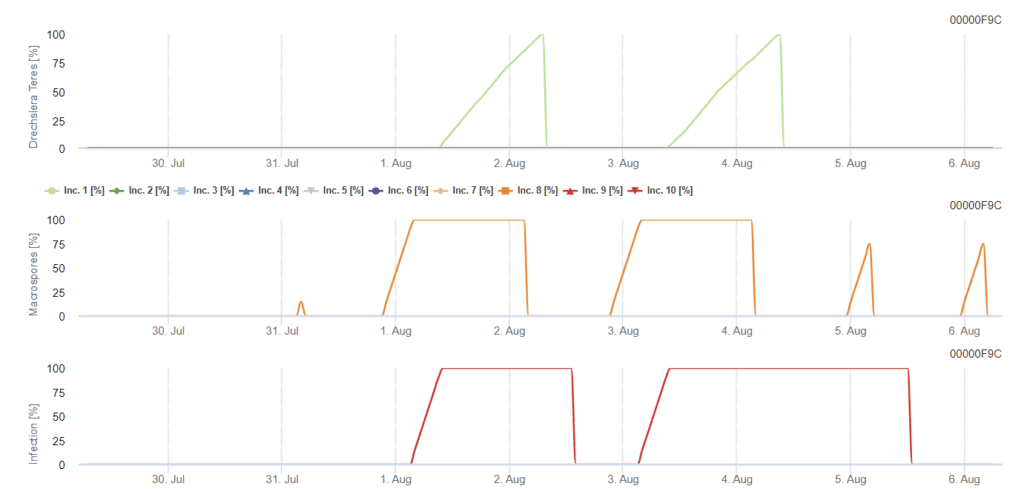
Sensors needed:
- Air Temperature
- Relative Humidity
- Leaf Wetness
- Precipitation
Primary inoculum develops under optimal temperatures between 15°C and 25°C with the optimum of 20°C. Conditions over 6 hours of darkness lead to optimal growth of conidia, as displayed in a conidia sporulation graph. If the sporulation graph reaches 100%, optimal conditions are set in the field.
Further dispersal takes place via wind or rain. Infections of plant tissues need humid conditions such as leaf wetness or high relative humidity for about 10 to 30 hours with optimal temperatures of 15°C and 25°C, as displayed in an infection graph. When it reaches 100%, it is determined that optimal conditions have been measured for the infection in the field. Sunlight can also enhance the growth of conidophores which produce conidia following altered conditions of humid and dry periods with high solar radiation and low relative humidity and wind favors the disease development.
Literature
- Backes, A., Guerriero, G., Ait Barka, E., & Jacquard, C. (2021). Pyrenophora teres: taxonomy, morphology, interaction with barley, and mode of control. Frontiers in plant science, 12, 614951.
- Liu, Z., Ellwood, S. R., Oliver, R. P., & Friesen, T. L. (2011). Pyrenophora teres: profile of an increasingly damaging barley pathogen. Molecular plant pathology, 12(1), 1-19.
- Obst, A., & Paul, VH (1993). Diseases and pests of cereals, Verlag Th. Mann, Gelsenkirchen-Buer.
Take-all
Pathogen
The disease ‘Take-all’, caused by Gaeumannomyces graminis, is one of the most devastating diseases in cereals. The name has come from south Australian farmers as the disease is so damaging that it leaves no grain for them to harvest. The pathogen harms the root system and the stem, causing water and nutrition deficiency, eventually leading to plant death.
The fungus survives as mycelia in crop debris saprophytically and soil-borne fragments can be transported by wind, water, and animals. Primary infection occurs once the roots of seedlings contact with infected debris, followed by hyphae growth and extension. By penetrating the root epidermis and invading the root cortex, it colonizes and destroys the tissues. The infection progresses upwards and downwards. Secondary infection takes place via root-to-root contact, with severely infected plants occurring in patches.
Symptoms
Take-all disease in wheat typically affects during the seedling and tillering stages, causing symptoms near the soil surface. Infected plants may become stunted, with yellowing leaves and prematurely maturing ears that lack fully developed kernels. Circular dead patches, ranging from a few centimeters to meters, often have yellow-orange or bronze margins and may reappear in the same area in subsequent years.
Key symptoms include bleached white or empty spikes, blackened stem bases, and dark, rotting roots with small black lesions that expand. Severely damaged roots are brittle, and a shiny black discoloration may appear on the basal stem. Plants can be easily pulled out from the soil due to their weakened root systems. The disease may resemble drought stress as it disrupts water flow to the upper parts of the plant, causing premature blighting.
FieldClimate model
Take-all
Model Sensors:
- Soil temperature
The take-all risk model implements the day length and soil temperature to determine the risky periods. Days with less than 13 hours of sunlight and soil temperatures between 10°C and 20°C favor the disease development.
When the risk value reaches 100%, optimal conditions for the pathogen development have been given in the field. Crop rotation with at least 2 to 3 year intervals between susceptible cereals is the most important protection strategy.
Literature
- Cook, R. J. (2003). Take-all of wheat. Physiological and Molecular Plant Pathology, 62(2), 73-86.
- Palma-Guerrero, J., Chancellor, T., Spong, J., Canning, G., Hammond, J., McMillan, V. E., & Hammond-Kosack, K. E. (2021). Take-all disease: new insights into an important wheat root pathogen. Trends in Plant Science, 26(8), 836-848. https://www.apsnet.org/edcenter/disandpath/fungalasco/pdlessons/Pages/Takeall.aspx
Fusarium head blight
Pathogen
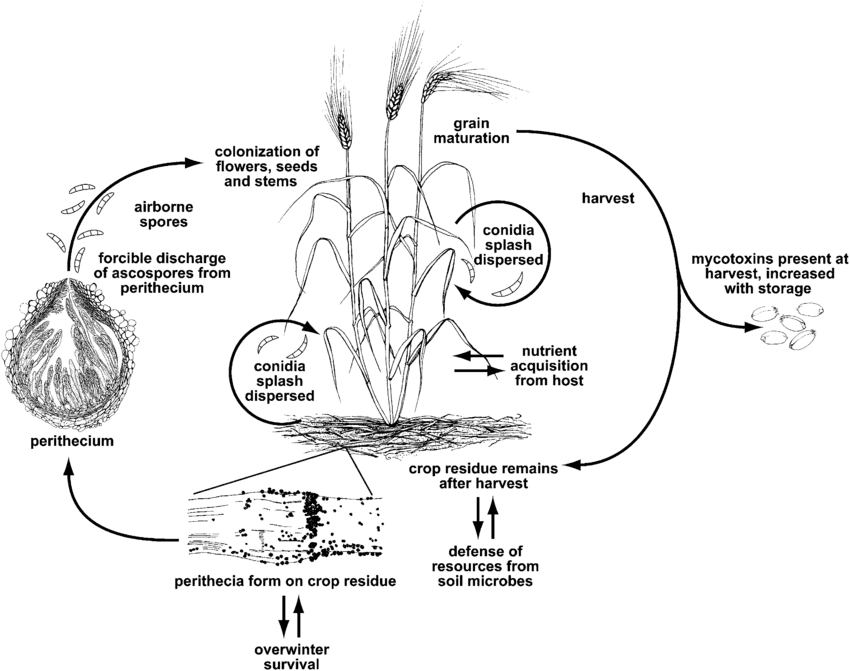
Fusarium head blight or scab is caused by the genus Fusarium. The most common species is Fusarium graminearum but the most prevalent species may differ depending on regions.
F. graminearum can infect wheat plants at any growth stages. It survives the winter on infected crop residues, and in spring, primary infection occurs when ascospores from perithecia and conidia are dispersed onto wheat glumes or anthers. Infected florets produce shrivleed or wilted kernels, often termed “tombstone” kernels. Even when kernels appear unaffected, they may still be contaminated with mycotoxins. Secondary infection occurs via conidia, but wheat epidemics primarily depend on the amount of primary inoculum rather than secondary sources.
Fusarium head blight also leads to the accumulation of harmful mycotoxin in crops, posing a potential risk to animals. These mycotoxins disable plant defense mechanism or protect the fungus against other organisms. The major toxin is deoxynivalenol (DON) and it inhibits protein synthesis, disrupting normal cell function. Humans who have consumed wheat with DON will experience symptoms like nausea, fever, or vomiting.
Symptoms
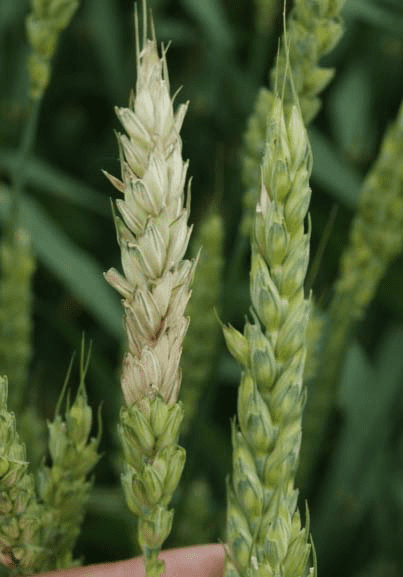
In wheat and durum, any part or all of the head may appear bleached. The partly white and green heads are diagnostic for the disease in wheat. The fungus may also infect the stem, causing a brown to purple discoloration. Pink to salmon orange spore masses are often seen on the infected spikelets and glumes during wet conditions. Many kernels are shriveled and lightweight and are sometimes called “tombstones” for their chalky, lifeless appearance. Under favorable conditions, the infection may spread to adjacent spikelets and infect the entire spike, including the rachis and peduncle. The kernels may have a dull appearance and pink discoloration in normal size when the infection has occurred late in the developmental stage.
In barley, infected spikelets turn bleached and show a water-soaked appearance. The kernels may also exhibit discoloration and occasionally, salmon-orange spore masses can be seen on the spikelet and glumes during wet conditions.
FieldClimate models
Estimates of FHB levels in a field are based on counts of blighted heads or kernels. The colored visual scale to estimate the severity of FHB in wheat is available from the NDSU Extension Service (publication PP-1095): https://library.ndsu.edu/ir/bitstream/handle/10365/9187/PP1095_1998.pdf?sequence=1&isAllowed=y.
Fusarium Head Blight Infection Model (Fusarium Head Blight Risk)
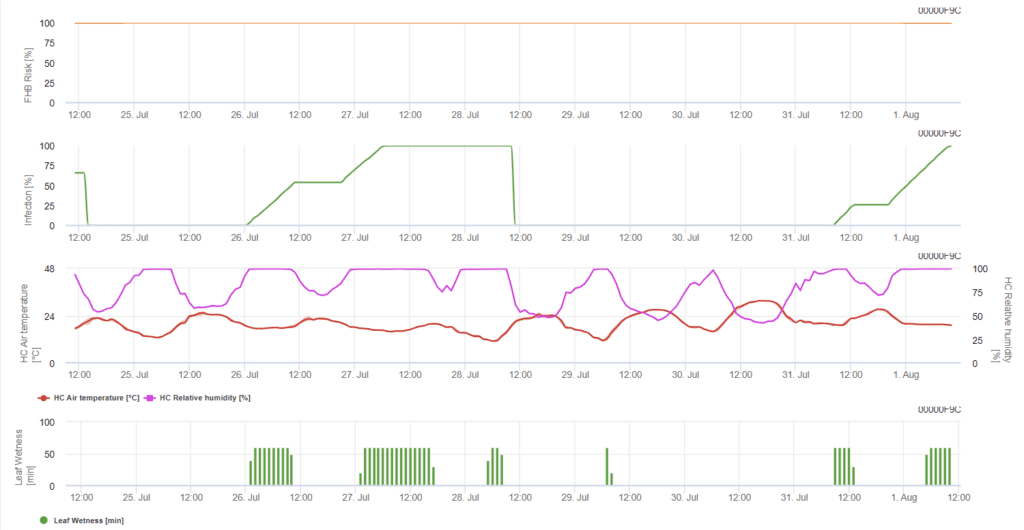
Sensors needed:
- Air temperature
- Relative humidity
- Leaf wetness
The model determines the risky periods for an infection. Whenever 100% infection is reached, the risk is very high, and conditions for the fungus have been favorable for infection. The farmer’s knowledge about the development stage of different wheat varieties give the possibility to decide an application of a curative spray immediately after the infection.
The fungal agents of the Fusarium Head Blight on wheat are favored by warm temperatures of 20°C to 30°C and long humid periods. Several day-long leaf wetness periods will lead to early visible symptoms. Symptoms can also be seen after a long latency period if the infection is followed by a leaf wetness period of 18 hours or even shorter and after an artificial inoculum at temperatures of 15°C.
Summarizing all the different temperatures and moisture combinations we found in the literature, we decided to point out Fusarium Head blight Infections if temperature and leaf wetness period or periods with more than 85% relative humidity exceed the values visualized in the following graph. The calculation of the progress value follows the relationship between the duration of moist conditions and the temperature.
Fusarium Mycotoxin Alert Model (Fusarium Head Blight)
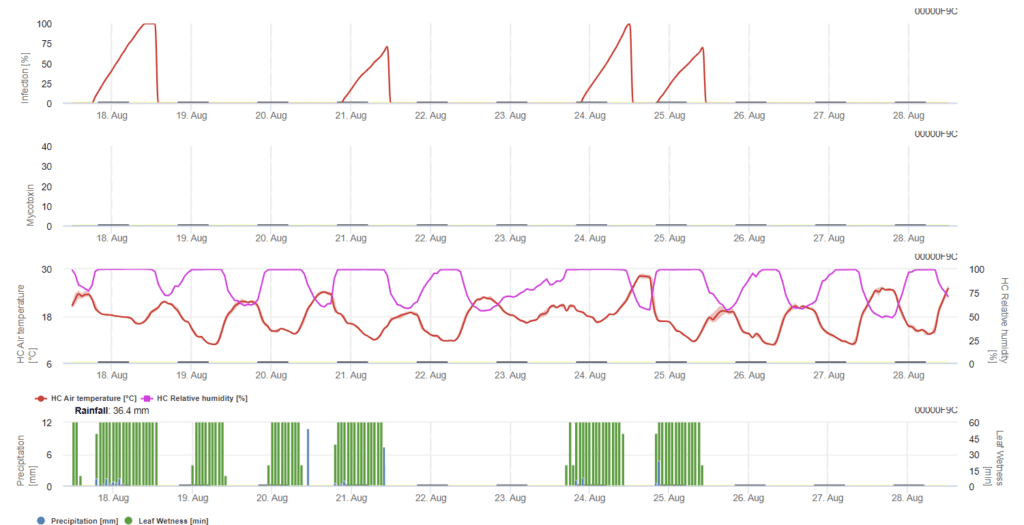
Sensors needed:
- Air temperature
- Relative humidity
- Leaf wetness
- Precipitation
The infection of the FHB is calculated by precipitation (2mm needed), relative humidity (above 85%), leaf wetness, and temperature during the process. If infection reaches 100%, optimal conditions for the fungal pathogen have been reached. Further on, the model figures out the FHB mycotoxin risk.
Infection trials with extended leaf wetness periods of Fusarium head blight lead to high contents in mycotoxin. From this information, a leaf wetness period of 48 hours or more during stages 61 and 69 is assumed to give a high risk of mycotoxins.
Experiences made throughout the analysis of DON in commercial-grown wheat showed that leaf wetness periods long enough for infection following an initial infection in stages 61 to 69 can increase the DON values. In case of longer leaf wetness periods, mycotoxins can increase up to stage 85.
- BBCH stage 61: Beginning of flowering; first anthers visible
- BBCH stage 69: End of flowering; all spikelets have completed flowering but some dehydrated anthers may remain
- BBCH stage 85: In the middle of ripening; soft dough with grain content soft but dry, fingernail impression not held
The model accumulates the risk figure proportional to the infection progress for every successful infection period over the selected period for the calculation. Six completed infections would lead to the risk of 100%. Normally, the leaf wetness period leading to a fusarium infection is longer than the minimum needed. Therefore, most fusarium infections will lead to a risk increase of more than 17%.
The mycotoxin risk value on the field history. Wheat grown after non-tillage wheat can only carry a small risk if it is not sprayed at the optimum situation. In unsprayed wheat, we have to expect increased DON values after 35% of the risk. Wheat after non-tillage wheat following any other crop can carry a higher risk of 50%. If we have wheat after wheat with tillage, the risk can be increased up to 70%. First-year wheat should be tested for DON if the risk reaches 100%.
Literature
- https://www.fao.org/4/y4011e/y4011e0j.htm
- https://scabusa.org/pdfs/NDSU_PP-804_FHB-Small-Grains.pdf
- Lancashire, P. D., Bleiholder, H., Boom, T. V. D., Langelüddeke, P., Stauss, R., Weber, E., & Witzenberger, A. (1991). A uniform decimal code for growth stages of crops and weeds. Annals of applied Biology, 119(3), 561-601.
- Trail, F. (2009). For blighted waves of grain: Fusarium graminearum in the postgenomics era. Plant physiology, 149(1), 103-110.
- Schumann, G. L. (2010). The Plant Health Instructor| Volume: 10| Year: 2010| Article Type: Lesson Plans. Plant Health, 10.
Barley stripe
Pathogen

Barley stripe is caused by Pyrenophora graminea (Drechslera graminea), a seed-borne pathogen that survives in an infected seed’s epidermis. The fungus infects seedlings under cool, moist conditions. The fungus grows systemically within the plant, infects the entire plant, produces toxins, kills cells, and discolors leaf tissue between veins, thus causing striped lesions. Stripe is more prevalent in winter barley than in spring barley.
When conditions are wet or humid, spores are produced on the leaf surface when healthy plant spikes bloom. Spores are dispersed by wind to these developing spikes, germinate, and cause infections. Kernels are most susceptible during early development. Only one cycle of infection and spore production occurs each season.
Symptoms
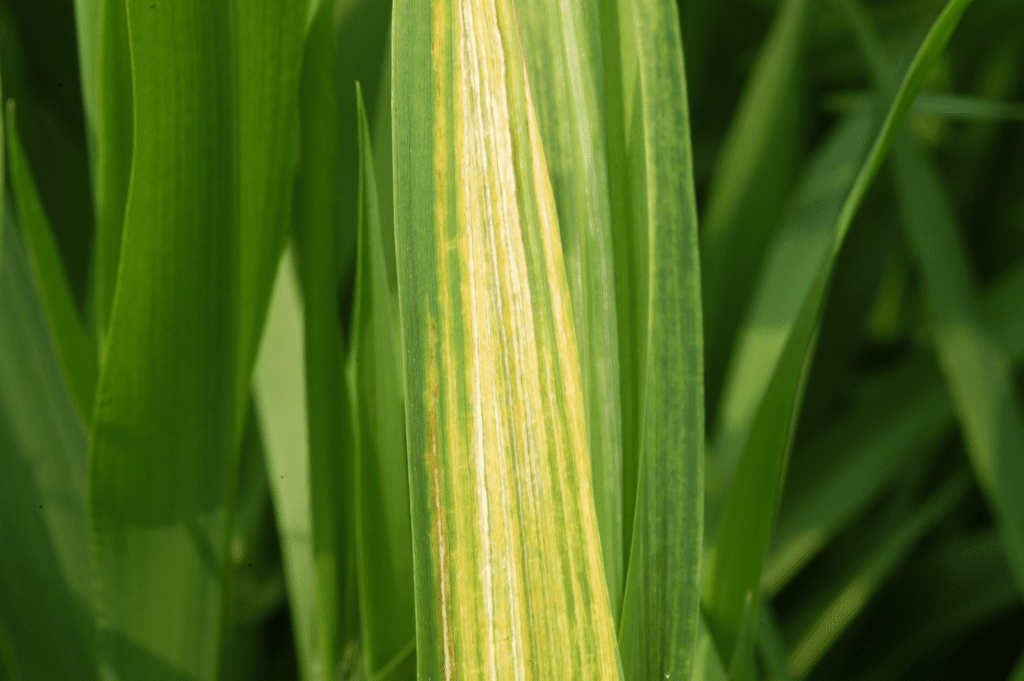
Symptoms are mostly prominent at the ear emergence stage.
Pale green to yellow stripes initially appear at the basal part of the leaf and leaf sheath. These stripes gradually turn brown to dark brown, followed by a drying-out and splitting of the leaf blade. They extend in size to the entire length of the leaf, become necrotic, and coalesce, eventually leading to the plant death.
Plants may appear stunted, produce few tillers, and do not head or produce seed in severe cases. Ear length can also be reduced due to poorly developed brown grains.
FieldClimate model
Pyrenophora graminea Model

Sensors needed:
- Air temperature
- Relative humidity
- Leaf wetness
- Precipitation
The model has two stages shown. The first stage is risky periods during emergency periods of the plant, early stages. The second stage is during flowering time and barley head development. When the infection reaches 100%, optimal conditions have been made in the field for the fungus to infect the plant tissues and grow systematically inside.
Literature
- Richardson, M. J. (1996). Seed mycology. Mycological Research, 100(4), 385-392. https://ahdb.org.uk/knowledge-library/barley-leaf-stripe-life-cycle-and-disease-symptoms https://plantwiseplusknowledgebank.org/doi/full/10.1079/pwkb.species.46115
Septoria
Pathogen
There are two major Septoria diseases in wheat – Septoria tritici blotch caused by Septoria tritici and Septoria nodorum blotch caused by Septoria nodorum.
Septoria tritici survives on infected crop residues during the summer and begins to infect wheat plants in the fall. The fungus thrives in cool and moist conditions. It has two stages – a latent phase and a necrotic phase. During the latent phase, the fungus inoculates new plant tissue and by entering through the stomata, colonization follows, which it grows intercellularly within the plant tissues. S. tritici does not require any physical feeding structures, rather it feeds itself by extracting nutrients from the host cells that have lost structural integrity. Plants may exhibit a hypersensitive response and necrotic lesions may develop on affected tissues as a response to infection.
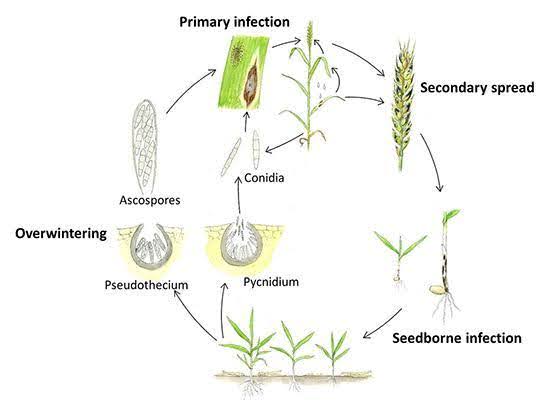
Septoria nodorum survives over the summer as dormant mycelia, pycnidia, and pseudothecia on crop residues. Infection typically begins in the autumn when pycnidiospores from pycnidia and ascospores from pseudothecia are dispersed by wind and rain, initiating primary infection. These spores penetrate the leaf cuticle and pycnidia formation follows after the infection. Secondary infection occurs as pycnidiospores are produced and dispersed from lower leaves to upper leaves and glumes. The pathogen also produces toxins that contribute to the disease development.
Symptoms
Septoria tritici blotch
In the fall, Septoria tritici symptoms initially appear as small yellow spots on the leaves, containing tiny black speckles, which are fungal fruiting bodies. The lesions are irregular in shape, ranging from elliptical to long and narrow, enlarge, and turn brown to reddish brown as mature. The disease typically starts on the lower leaves and gradually moves upward, eventually affecting the flag leaf. During wet conditions, the fungus may spread to wheat heads, causing brown lesions on the glumes and awns, known as glume blotch. Septoria tritici blotch can be mistaken for other wheat diseases. However, the presence of black fungal bodies is a key feature of S. tritici. Although Septoria nodorum can also produce brown fruiting bodies in wet conditions, they differ in color and size, with Septoria tritici fruiting bodies being larger.
Septoria nodorum blotch
Septoria nodorum symptoms appear mainly on the upper leaves first. Initially, dark brown spots with a yellow halo appear on leaves. Tip burn of the leaves is another initial indication. The lesions expand and become necrotic with a dark brown center as mature. Tiny dark brown structures are visible within the lesions, which are fruiting bodies. Conidia released from the fruiting bodies would look white to pink masses. Severely infected leaves may be completely covered by lesions, eventually resulting in the death of the leaf tissue. The fungus can also affect glumes and awns: similar brown lesions appear and the disease progresses downward.
FieldClimate model
Septoria infections are possible at low temperatures whereas temperatures below 7°C might not lead to an infection within 2 days. The optimum temperature of the disease is reached in the area of 16 to 21°C. Infections are possible within a period of high relative humidity or leaf wetness of 14 hours or longer.
Septoria tritici Model
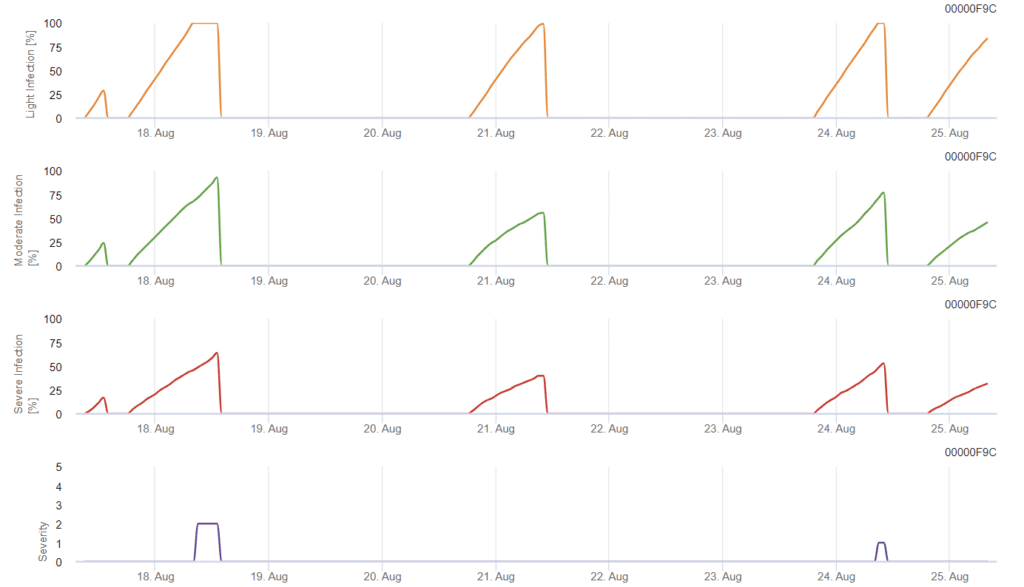

The infection starts after the rain of 0.5mm. The optimal temperatures for Septoria infections are around 16°C to 21°C and leaf wetness or high relative humidity over 14 hours. Septoria tritici is calculated in three severity classes. Further, we determine severity levels that support to assessment of the infection pressure between the BBCH stages 10 to 32 of wheat.
- BBCH stage 10: Leaf development; first leaf through coleoptile
- BBCH stage 32: Stem elongation; node 2 at least 2cm above node 1
- BBCH stage 51: Inflorescence emergence and heading; beginning of heading with tip of inflorescence emerged from sheath and first spikelet just visible.
We have decided not to use a model for pycnidia formation. The condition needed for pycnidia formation is assumed to be a period with relative humidity higher than 85%. Pycnidia’s lifetime is 24 hours. In all climates where the fungus has a chance to infect, we will find two hours fulfilling this condition nearly every day around sunrise.
Infection severity evaluation
To assess the Septoria tritici infection pressure between stages 10 and 32 and between 32 and 51, we have to assess the severity of infections based on climatic conditions. The infection severity is assessed on a 1 to 5 scale:
- 1: weak infection with rain less than 5mm
- 2: weak infection with rain more than 5mm
- 3: moderate infection with rain less than 5mm
- 4: moderate infection with rain more than 5mm/ severe infection with rain less than 5mm
- 5: severe infection with rain more than 5mm
Disease pressure evaluation
There are three factors for the disease pressure in the field – climate, field history, and the susceptibility of the variety grown. If we can accumulate the disease severity values from stage 10 to stage 32 to the value of 4, we can expect a weak disease pressure by the climate. If this value reaches 6, we can expect a moderate disease pressure, and if it reaches 10, a higher disease pressure from the climate.
Knowing the susceptibility of the variety and the field history will lead us to spray or not on a weak or moderate disease pressure in the situation. Having an accumulated value of 10 may lead to a spray in stage 32 anyhow.
The decision to spray at a later stage depends on the spring climate. If we can accumulate the severity values from stage 10 to a value of 6, we can expect a weak disease pressure. If this value reaches 10, we can expect a moderate disease pressure and if this value reaches 15, we can expect a high disease pressure from the climate situation.
In FieldClimate, the Septoria tritici severity together with the three different infection severities is displayed. Due to rainfall and long leaf wetness periods, conditions for a severe infection by S. tritici have been fulfilled. The severity levels reach the highest value of 5, which means that a high risk for infection is present.
Septoria nodorum Model
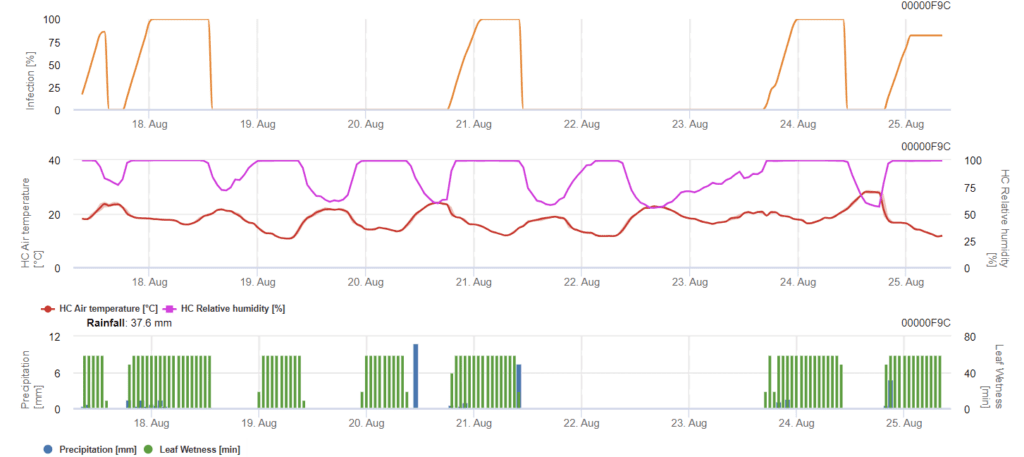
Septoria nodorum’s infection biology differs to some extent from Septoria tritici but the difference is not big enough for a separate model. Therefore, we suggest using the tritici model for the whole complex of Septoria disease. In areas with high pressure of S. nodorum, infections classified as a weak with severity value of 2 should be treated more seriously than in other areas.
The Septoria nodorum model calculates the risk of the disease. Plant protection measurements should be considered if the risk reaches 80%. When the risk is 100% and infection is already determined, systemic plant protection measurements (curative applications) should be taken.
Literature
- Brennan, C. J., Benbow, H. R., Mullins, E., & Doohan, F. M. (2019). A review of the known unknowns in the early stages of septoria tritici blotch disease of wheat. Plant Pathology, 68(8), 1427-1438.
- De Wolf, E. D. (2008). Septoria tritici blotch. Mehra, L. K., Adhikari, U., Ojiambo, P. S., & Cowger, C. (2019). Septoria nodorum blotch of wheat. The Plant Health Instructor.
- Solomon, P. S., Lowe, R. G., TAN, K. C., Waters, O. D., & Oliver, R. P. (2006). Stagonospora nodorum: cause of stagonospora nodorum blotch of wheat. Molecular plant pathology, 7(3), 147-156.
Leaf blotch
Pathogen
Leaf blotch is caused by Rynchosporium secalis.
Primary infection occurs by ascospores or conidia on crop debris. These spores are dispersed by wind and rain, germinate, and as epidermal and mesophyll cells collapse after an infection, symptoms become visible. Secondary infection is driven by conidia from infected leaves. In humid conditions, conidia germinate on the leaf surface and produce hyphae that penetrate the cuticle directly above epidermal cells. Subsequent fungal growth is confined to the subcuticular region of the epidermis.
Symptoms
R. secalis can infect any part of the leaves. Irregular-shaped blotches are the key characteristic and the infection starts from the bottom to the upper leaves. Blotches initially appear as water-soaked areas. As the disease progresses, they become greyish in the center due to spore formation with a brown margin. Necrosis and chlorosis may follow. The blotches coalesce, destroying the entire leaves.
FieldClimate model
Leaf Blotch Rynchosporium Model
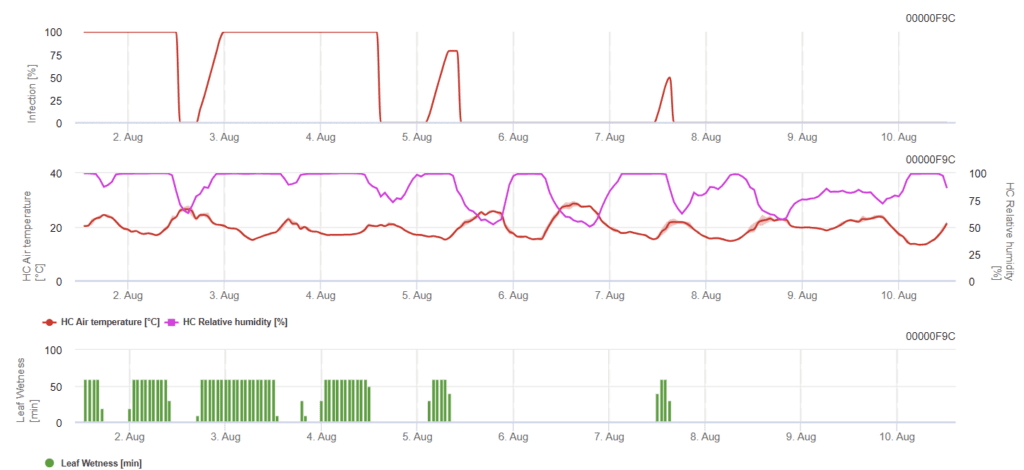
Sensors needed:
- Air temperature
- Relative humidity
- Leaf wetness
For an infection to occur, a minimum of 7 to 15 hours of lead wetness is needed, depending on the temperature (optimum at 20’C). When the graph reaches 100%, it means that optimal conditions have been determined in the field.
Literature
- Brooks, F. T. (1928). Observations on Rhynchosporium secalis (Oud.) Davis, leaf blotch of barley and rye. New Phytologist, 27(4), 215-219.
- Fowler, A. M., & Owen, H. (1971). Studies on leaf blotch of barley (Rhynchosporium secalis). Transactions of the British Mycological Society, 56(1), 137-152.
- Zhan, J., Fitt, B. D., Pinnschmidt, H. O., Oxley, S. J. P., & Newton, A. C. (2008). Resistance, epidemiology and sustainable management of Rhynchosporium secalis populations on barley. Plant pathology, 57(1), 1-14.
Ramularia leaf spot
Pathogen
Ramularia collo-cygni, the causal agent of Ramularia leaf spot on barley, primarily spread through asexual reproduction via conidia, which require moisture for germination and early development. After germination on the leaf surface, the fungus enters the leaf through stomata and colonizes the tissue intercellularly. Infected barley plants may show no symptoms initially, but damage typically appears after flowering.
The life cycle of R. collo-cygni is not fully understood, but it involves vertical transmission through infected seeds, allowing the pathogen to survive between growing seasons. Airborne conidia also contribute to secondary spread, initiating new infections under favorable conditions. While seeds are the primary overwintering mechanism, the role of alternate hosts and a secondary fungal structure called Asteromella remains uncertain and is still under study.
Symptoms
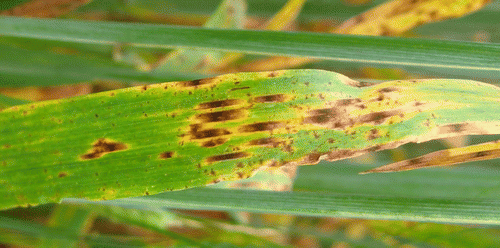
Symptoms appear on both sides of leaves after flowering in general but are more common on upper leaves. Initial symptoms appear as yellow to brown spots by leaf veins surrounded by a chlorotic halo. Once leaf spots emerge, the leaf becomes chlorotic and necrotic, typically beginning from the leaf tip and margins. Neighboring spots may meet, creating larger dark areas. Small punctiform spots can be observed as well. Although the symptoms of Ramularia leaf spot can be confused with other diseases, the key feature is that leaf spots are delimited to leaf veins.
There are so-called 5R for distinguishing Ramularia leaf spots:
- Ringed with a yellow margin of chlorosis
- Rectangular shape
- Restricted by the leaf veins
- Reddish-brown coloration
- Right through the leaf
FieldClimate Model
Ramularia Model
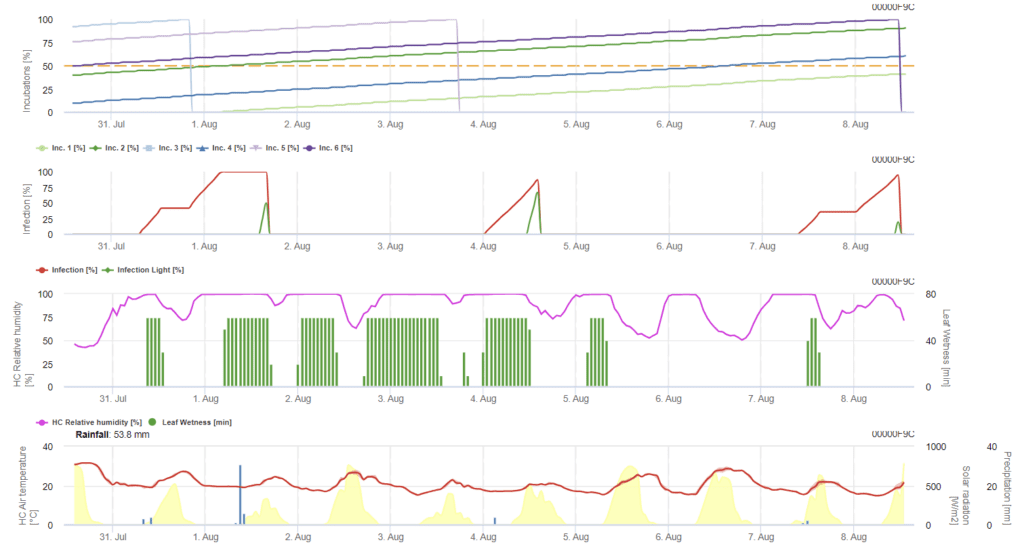
The Ramularia infection on barley is mostly driven by humid conditions. Thus, we start the calculation with a rain event, followed by leaf wetness or relative humidity higher than 85%.
There are two ways of an infection described:
- Infection: once where humid conditions merely promote an infection event
- Infection: once when global radiation is needed to finish an infection event
Further on, whenever 100% infection is reached, the model starts to determine the incubation time. When incubation reaches 50%, controlling the field for new inoculum is recommended and when it reaches 100%, necrotic lesions on leaves are predicted.
Literature
- Havis, N. D., Brown, J. K., Clemente, G., Frei, P., Jedryczka, M., Kaczmarek, J., … & Hess, M. (2015). Ramularia collo-cygni—an emerging pathogen of barley crops. Phytopathology, 105(7), 895-904.
- Huss, H. (2002, April). The biology of Ramularia collo-cygni. In Proc. Second Int. Workshop Barley Leaf Blights. Aleppo, Syria (pp. 321-328).
- Walters, D. R., Havis, N. D., & Oxley, S. J. (2008). Ramularia collo-cygni: the biology of an emerging pathogen of barley. FEMS Microbiology Letters, 279(1), 1-7. https://grdc.com.au/__data/assets/pdf_file/0025/443509/GRDC_FS2103_Ramularia_03.pdf
Rhizoctonia solani
Pathogen
Rhizoctonia root rot in wheat is caused by Rhizoctonia solani. The pathogen can survive for many years in the soil as sclerotia. In some cases, it also survives as mycelia on plant debris. Once the temperature rises, sclerotia become active and generate a mass of hyphae, enabling infection by attaching to roots. The mycelium produces so-called “infection cushions” and the fungus invades and colonizes the root tissue. Root infection weakens seedlings, resulting in poor growth, and reduces the capacity to transport water and nutrients to aboveground plant tissues, eventually leading to plant death.
Symptoms
Early on, bare patches appear, varying in size from a few centimeters to several meters in diameter. These bare patches are often associated with stunted plants that may exhibit yellowing, wilting, or even a purple coloration. Infected plants can be severely stunted and show signs of drought stress or nutrient deficiency, which can lead to premature death in some cases.
Reddish brown lesions develop on stems and roots below the soil line, and these lesions get sunken as the disease progresses. Root rot can reduce nodulation and cause the root cortex to be easily breakable, resulting in brown spear tips.
FieldClimate model
Rhizoctonia solani Risk Model
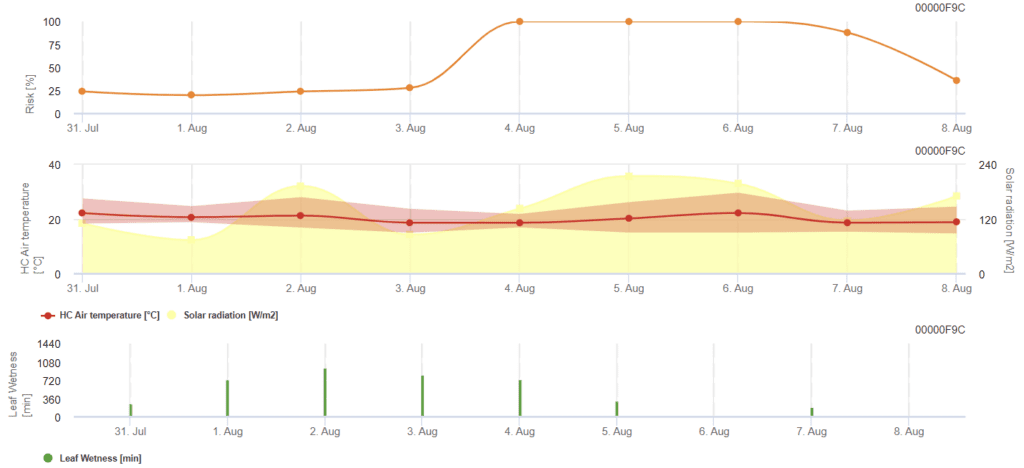
Sensors needed:
- Air temperature
- Solar radiation
- Leaf wetness
The model calculates risky periods of Rhizoctonia solani by checking conditions of the last 120 hours. It results in a risk value of 0 to 100, indicating favorable conditions for the disease.
No sprays are needed when the risk is low. In moderate-risk periods, the spray interval can be prolonged, and in periods with high risk, it may have to be reduced, or more effective compound usage would be recommended.
In case of consecutive leaf wetness, it accumulates temperature-depending values for every minute:
- 12 °C to 15 °C: accumulation of 1 per minute
- 16 °C to 17 °C: accumulation of 2 per minute
- 18°C and more: accumulation of 4 per minute
At the end of the leaf wetness periods, it evaluates the accumulated values:
- Values > 4096: Risk increases by 64 points and subtraction of 4096 from the value
- Residue values > 2048: Risk increases by 16 points and subtraction of 2048 from the value
- Residue values >1024: Risk increases by 4 and subtraction of 1024 from the value
If the global radiation is consecutive higher than 800 W/m², it accumulates time in minutes and evaluates the values when radiation gets lower:
- Value > 512: Risk – 32 points, value – 512
- Value > 256: Risk – 8 points, value – 256
- Value > 128: Risk – 2 points, value – 128
Literature
- https://cropprotectionnetwork.org/encyclopedia/rhizoctonia-root-rot-of-wheat#:~:text=It%20is%20caused%20by%20Rhizoctonia,result%20in%20premature%20plant%20death.
- https://ahdb.org.uk/knowledge-library/rhizoctonia-stunt-symptoms-and-risk-in-cereals
- https://cropwatch.unl.edu/rhizoctonia-root-rot#:~:text=Disease%20Symptoms&text=These%20reddish%20brown%20lesions%20may,uneven%20because%20of%20stunted%20plants.
- https://extensionaus.com.au/FieldCropDiseasesVic/docs/identification-management-of-field-crop-diseases-in-victoria/soil-borne-diseases/rhizoctonia-root-rot/
- https://www.florimond-desprez.com/es/wp-content/uploads/sites/6/2015/11/rhizoctonia_eng.pdf
Powdery mildew
Pathogen

Blumeria graminis is the pathogen of powdery mildew in wheat and barley. It can overwinter as mycelia or cleistothecia. In the spring, spores germinate and infect host plants under cool and humid conditions, without requiring free water on the plant surfaces.
The fungus reproduces both asexually and sexually.
In the asexual cycle, the pathogen undergoes rapid cycles of infection and conidia (asexual spores) production, which are key to the spread of the disease. Conidia are produced in the mycelium every 7 to 10 days under favorable conditions. Once dispersed by wind, these conidia land on a new host, germinate, and form appressoria and haustoria to extract nutrients from the plant. Conidia of Blumeria graminis can germinate even at low humidity and over various temperatures.
In the sexual cycle, the fungus produces cleistothecia, hardy structures that can survive adverse conditions well. Cleistothecia contain ascospores (sexual spores) and new infections are initiated when these spores are released.
Symptoms
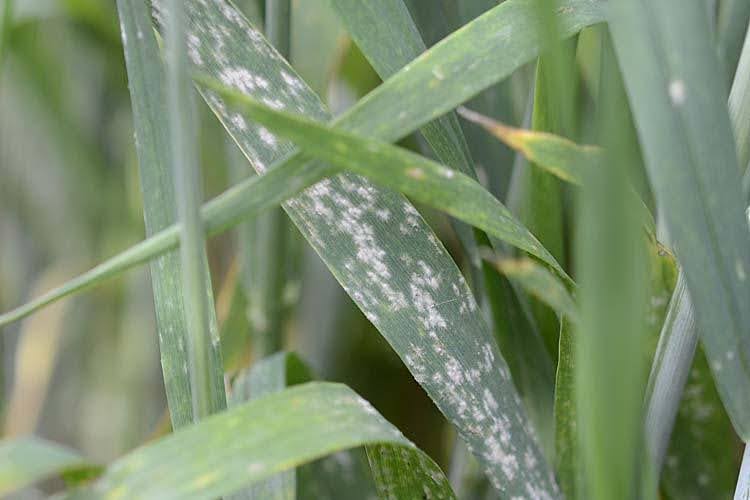
Powdery mildew in wheat and barley affects grain yield by reducing the number of heads and diminishing kernel size and weight. The earlier the infection occurs, the greater the damage will be.
Barley exhibits age-related resistance to powdery mildew. As barley matures, instead of the typical mycelium patches, sharply defined, black-brown spots (“tar-spots”) may appear on leaves.
Wheat is particularly susceptible to powdery mildew between the tillering and milk ripeness period, especially when the flag leaves and husks are affected. However, compared to barley, wheat can tolerate early infections better.
White-grayish powdery mildew develops on leaves, stems, and heads. The fungal growth is most prominent on the upper leaf surface, though it may also develop on the underside. Initially, pustules appear white but gradually turn gray to brown as they mature and they may coalesce, forming larger masses often surrounded by chlorosis. On the opposite side of the infected leaves, tissues become yellow, later turning tan or brown. Cleistothecia are visible as well, as small, round, black dots within older gray colonies. In severe cases, leaves may die.
FieldClimate model
Wheat Powdery Mildew Model

Sensors needed:
- Air temperature
- Leaf wetness
- Solar radiation
The model determines the risk of powdery mildew varying on a scale from 0 (no infection) to 100% (full infection). It is relevant during the BBCH stage of 21 to 39 for barley and of 21 to 75 for wheat and oats.
BBCH stage is a growth scale to describe the development of plants. There are two digits, the scale ranges from 00 to 99 – 00 refers to seed treatment and 99 is when post-harvest treatment takes place. The first digit infers the specific stage of development; 0 is germination, 1 is leaf development, 2 is tilling, 3 is stem elongation, 4 is booting, 5 is inflorescence emergence and heading, 6 is flowering, and anthesis, 7 is fruit development, 8 is ripening, and 9 is senescence.
- BBCH 21: Tillering – Beginning of tillering; first tiller detectable.
- BBCH 39: Stem elongation – flag leaf stage; flag leaf fully unrolled and ligule just visible.
- BBCH 75: Development of fruit – medium milk; grain content milky and grains reach final size but still green.
Risk increases within the temperatures between 12 °C and 21°C for most hours of the day and low global radiation. Leaf wetness, high global radiation, and high temperatures above 32°C decrease the risk in contrast.
Literature
- Both, M., & Spanu, P. D. (2004). Blumeria graminis f. sp. hordei, an obligate pathogen of barley. Annual Plant Reviews, 11, 202-218.
- Cunfer, B. M. (2002). Powdery mildew. Bread Wheat: Improvement and Production, 30, 317-330.
- Der Gräser, E. M. Krankheiten und Schädlinge des Getreides. Lancashire, P. D., Bleiholder, H., Boom, T. V. D., Langelüddeke, P., Stauss, R., Weber, E., & Witzenberger, A. (1991). A uniform decimal code for growth stages of crops and weeds. Annals of applied Biology, 119(3), 561-601. https://ohioline.osu.edu/factsheet/plpath-cer-11
Brown rust
Pathogen
There are three significant rust and pathogens:
- Leaf/ Brown rust: Puccinia triticina
- Stem/ Black rust: Puccinia graminis
- Stripe/ Yellow rust: Puccinia striiformis
Brown rust is the most common wheat rust disease. Black rust is also known as summer rust due to the abundant shiny black teliospore development. It is the most devastating rust disease, causing 50 percent of losses in one month under favorable conditions. Yellow rust is a disease of wheat in cooler climates, generally associated with higher elevations and northern latitudes. Its characteristics are the yellow-colored urediniospores. It can also cause damage as significant as black rust in severe cases.
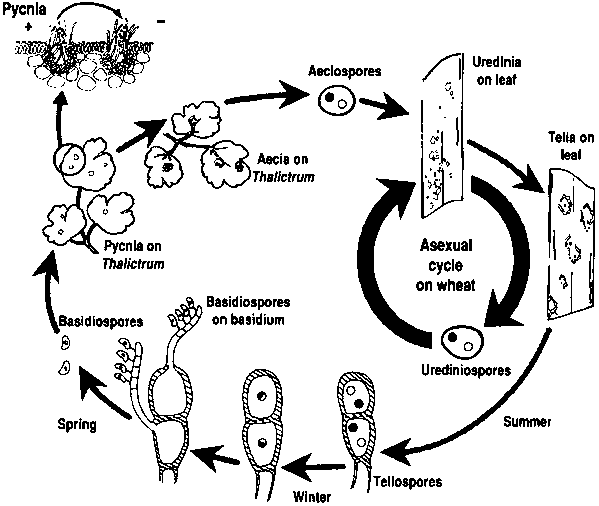
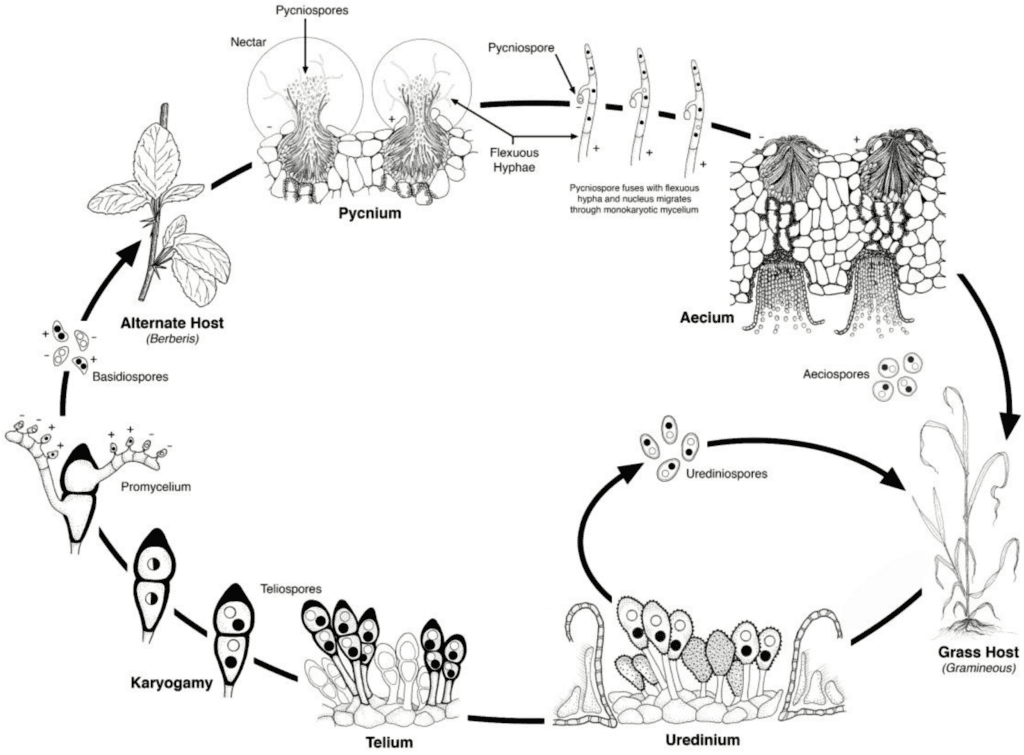
Wheat rust pathogens undergo both asexual and sexual reproductive cycles and require two host plants—an economic host and an alternate host. The economic host is wheat, and the alternative host is typically a weed or native plant, enabling the fungi to go through the sexual phase. Puccinia striiformis is not known to have any alternate host, consisting of uredinial and telial stages.
In the asexual cycle, urediniospores are produced on the host plant and can continue to infect it repeatedly, leading to rapid and widespread infection under favorable conditions.
The sexual cycle of the pathogen begins when teliospores, formed in uredinial infections on the host plant, germinate and undergo meiosis to produce basidiospores. These basidiospores are dispersed to an alternative host, where they initiate infection, resulting in pycnia formation that contains pycniospores and receptive hyphae. Fertilization occurs when pycniospores from one mating type are transferred to the opposite via nectar. Following fertilization, aecial cups develop on the underside of the alternative host’s leaves, which release aeciospores. These aeciospores are dispersed and infect new hosts, uredinial infection follows, completing the pathogen’s life cycle.
Symptoms
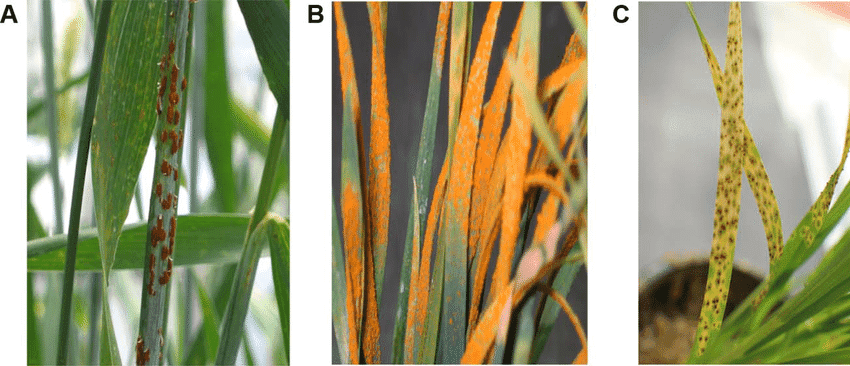
A) Puccinia graminis
B) Puccinia striiformis
C) Puccinia triticina
Puccinia triticina
P. triticina primarily infects leaf blades but can occasionally affect leaf sheaths, glumes, and awns, forming small yellow spots on the upper leaf surface. These spots develop into orange-colored pustules surrounded by a yellow halo as the disease progresses. The pustules produce orange or black spores visible on the leaves. It produces fewer teliospores, unlike black rust. Some may exhibit hypersensitive flecks or uredinia surrounded by chlorotic or necrotic areas.
Puccinia graminis
P. graminis mainly targets stems but can also infect leaves, sheaths, glumes, awns, and even seeds. Initially, reddish brown lesions appear and as the disease progresses, black teliospores form within the pustules. Masses of red-brick urediniospores develop first on stems and leaf sheaths and small chlorotic flecks emerge, which develop into linear or diamond-shaped pustules that may expand in size. As mature, the urediniospore production halts and a layer of black teliospores is produced, causing stems to appear blackened late in the season. In severe cases, the infection weakens plant stems, leading to lodging.
Puccinia striiformis
The characteristic feature of P. striiformis is the presence of straight-sided yellow pustules. TJey appear in narrow, elongated stripes of various lengths, often accompanied by chlorosis and necrosis. As the disease matures, yellow-orange spores develop within the pustules and the surrounding tissues turn brown and dry out, creating a scorched appearance.
FieldClimate model
Puccinia Rust Model
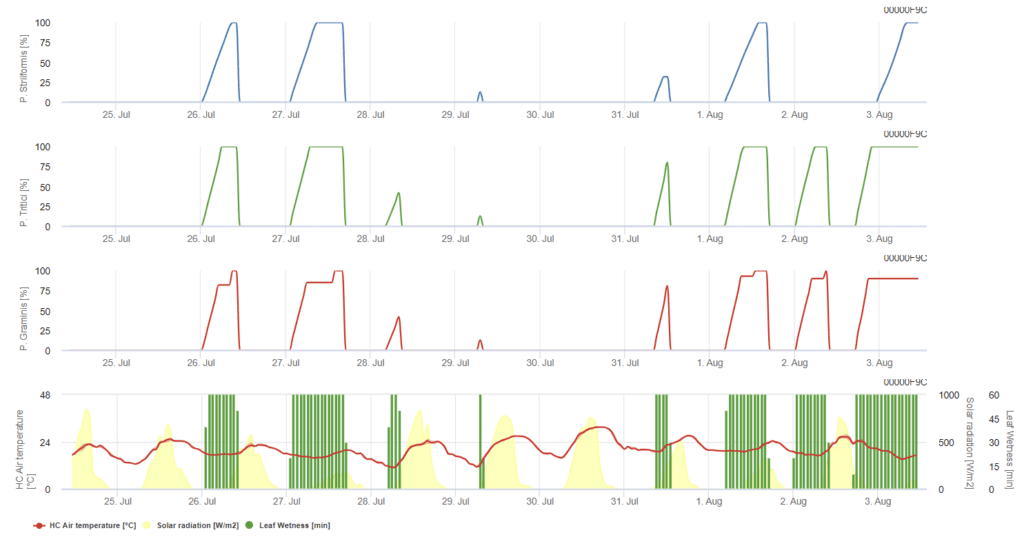
P. triticina, P. graminis, P. striiformis are each presented in three different colored graphs.
Puccinia triticna Infection Model
The model assumes that infection needs an accumulated hourly temperature of 90°C of leaf wetness in an air temperature range from 5°C to 30°C. Conditions are similar to P. graminis, but with a lower temperature threshold of 5°C.
If 100% infection is shown, a curative plant protection measurement should be considered. If the risk is at 80% and the weather forecast predicts more leaf wetness periods, protective leaf applications could be taken.
Leaf wetness for accumulated hourly average temperatures for 90°C:
- (if T <= 22.5°C then ∑(Th) else ∑ (22.5-(Th-22.5))
- 5°C < Temp. < 30°C
Puccinia graminis Infection Model
Infections take place after some hours of leaf wetness at optimum temperature conditions. The model assumes that infection needs an accumulated hourly temperature of 80°C of leaf wetness in an air temperature range from 10°C to 35°C. It prefers a little higher temperature than P. triticina and the infection has to be followed by sunlight.
When 100% infection is shown, the conditions have been favorable for the fungus and thus, plant protection measurements should be considered.
Leaf wetness for accumulated hourly average temperatures for 80°C followed by a light period (150 W/m²) for accumulated hourly average temperatures for 30°C:
- (if T <= 24°C then ∑(Th) else ∑ (Th-24))
- 10°C < Temp. < 35°C
Puccinia striiformis Infection Model
Puccinia striiformis is the wheat rust of cool climates having its optimum temperature already from 15°C on. Infections take place after some hours of leaf wetness at optimum temperature conditions. The model assumes that infection needs an accumulated hourly temperature of 80°C of leaf wetness in an air temperature range from 5°C to 20°C. There are no infections in periods with low light intensity.
Before the graph reaches 100%, protective application could be done whereas after it does, curative protection strategies (systemic) should be considered.
Leaf wetness and light for accumulated hourly average temperatures for 80°C:
- (if T <= 15°C then ∑(Th) else ∑ (Th-15))
- 5°C < Temp. < 20°C
Literature
- Bolton, M. D., Kolmer, J. A., & Garvin, D. F. (2008). Wheat leaf rust caused by Puccinia triticina. Molecular plant pathology, 9(5), 563-575.
- Chen, X. M. (2005). Epidemiology and control of stripe rust [Puccinia striiformis f. sp. tritici] on wheat. Canadian journal of plant pathology, 27(3), 314-337.
- Figueroa, M., Hammond‐Kosack, K. E., & Solomon, P. S. (2018). A review of wheat diseases—a field perspective. Molecular plant pathology, 19(6), 1523-1536.
- Guide, A. Leaf, Stem, and Stripe Rust Diseases of Wheat. Leonard, K. J., & Szabo, L. J. (2005). Stem rust of small grains and grasses caused by Puccinia graminis. Molecular plant pathology, 6(2), 99-111.
- Kolmer, J. (2013). Leaf rust of wheat: pathogen biology, variation and host resistance. Forests, 4(1), 70-84.
- Singh, R. P., Huerta-Espino, J., Roelfs, A. P., & Curtis, B. C. (2002). The wheat rusts. Growth, 2(25), 35.
Recommended equipment
Check which sensor set is needed for monitoring this crop’s potential diseases.
